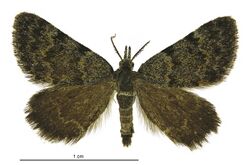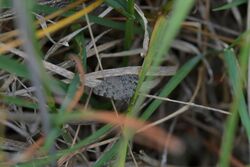Biology:Dichromodes cynica
| Dichromodes cynica | |
|---|---|

| |
| Female | |

| |
| Male | |
| Scientific classification | |
| Domain: | Eukaryota |
| Kingdom: | Animalia |
| Phylum: | Arthropoda |
| Class: | Insecta |
| Order: | Lepidoptera |
| Family: | Geometridae |
| Genus: | Dichromodes |
| Species: | D. cynica
|
| Binomial name | |
| Dichromodes cynica Meyrick, 1911
| |
Dichromodes cynica (also known as the rock face moth)[1] is a moth of the family Geometridae.[2] It was first described by Edward Meyrick in 1911. D. cynica is endemic to New Zealand and is found only around Christchurch and Banks Peninsular. The larvae of D. cynica are cryptic in appearance and feed on lichens growing on dry sunny rock faces. Adults are on the wing from September to February. D. cynica are active during the day and are rapid fliers.
Taxonomy
This species was first described by Edward Meyrick in 1911 using a specimen collected by George Hudson at Lyttelton in November.[3] George Hudson discussed and illustrated this species in his 1928 book The butterflies and moths of New Zealand.[4] The male holotype is held at the Natural History Museum, London.[5]
Description
The larvae of this species are cryptic, camouflaging themselves against their host species of lichens.[6][7]
Hudson described the larvae as follows:
The length of the larva was 1⁄2 inches. Blackish-grey, glacous-grey on sides; large dorsal spots on segments 6 to 9, small dorsal spots on segments 10 to 12, light grey. Body surface covered with minute tubercles and narrow transverse folds.[7]
Meyrick described this species as follows:
♂. 17mm. Head, palpi, thorax, and abdomen blackish-grey, slightly whitish-sprinkled, palpi 3 ½. Antennal pectinations 6. Forewings triangular, costa faintly sinuate, apex rounded-obtuse, termen obliquely rounded; dark grey sprinkled with black and grey-whitish, veins partially suffused with yellow-ochreous irroration; lines obscurely indicated by whitish irroration, irregular, first somewhat sinuate, indented below middle, edged posteriorly with black irroration becoming broad towards costa, second slightly prominent near costa and dorsum, and with a moderate bidentate prominence in middle, edged anteriorly with black irroration also becoming broad towards costa, subterminal hardly traceable; a small blackish transverse discal mark before second line: cilia dark grey, slightly sprinkled with black and whitish. Hindwings with termen rounded; dark fuscous; a fine indistinct grey-whitish curved post-median line, sinuate inwards in middle: cilia dark fuscous.[3]
This species is similar in appearance to D. sphaeriata but is smaller.[8]
Distribution
It is endemic to New Zealand.[9] This species is found only around Christchurch and the Banks Peninsular. As well as the type locality, this species has also been observed at Mount Grey.[4]
Behaviour
The larvae of D. cynica feed on lichens growing on dry sunny rock faces.[6] The adults of this species are on the wing from September to February.[10] This species is active during the day and flies rapidly.[4][6]
References
- ↑ Scott Hooson (19 January 2015). Christchurch District Plan Site of Ecological Significance: Oashore (Report). Christchurch City Council. pp. 1–17. https://districtplan.ccc.govt.nz/Images/DistrictPlanImages/Site%20of%20Ecological%20Significance/SES%20A%2023.pdf. Retrieved 11 April 2023.
- ↑ , pp. 460, Wikidata Q45922947
- ↑ 3.0 3.1 , pp. 60, Wikidata Q58200989
- ↑ 4.0 4.1 4.2 , pp. 134, Wikidata Q58593286
- ↑ , pp. 191, Wikidata Q45083134
- ↑ 6.0 6.1 6.2 "SUMNER ROAD RE-OPENING PROJECT ASSESSMENT OF ENVIRONMENTAL EFFECTS: - ECOLOGY". January 2014. https://api.ecan.govt.nz/TrimPublicAPI/documents/download/2244290.
- ↑ 7.0 7.1 , pp. 412, Wikidata Q109420935
- ↑ Patrick, Brian (2020-09-15). "Dichromodes cynica" (in en). https://www.inaturalist.org/observations/59665574.
- ↑ "Dichromodes cynica Meyrick, 1911". https://www.nzor.org.nz/names/7cad9595-56b0-43d2-a4e2-2dd42c321b3d.
- ↑ "Dichromodes cynica" (in en). https://www.inaturalist.org/taxa/514756-Dichromodes-cynica.
Wikidata ☰ Q13536201 entry
 |



